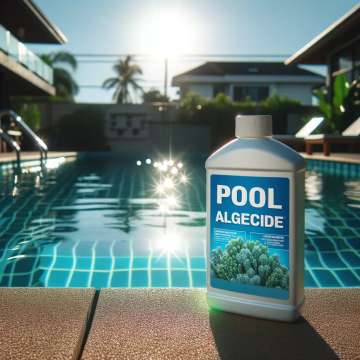Maintaining clean pool water and preventing algae growth requires the regular use of algaecide, but how much should you use? Getting the dosage right not only ensures effective algae removal but also prevents wasting chemicals. Let’s dive into how you can determine the correct amount of algaecide for your pool.

I. Understand Your Pool’s Volume
First, you need to know your pool’s volume because the amount of algaecide you’ll need depends on it. Pool volume is usually measured in gallons or liters, and you can find this information in your pool’s manual or by using an online pool volume calculator. Simply input your pool’s length, width, and average depth to calculate the total volume. Knowing this number is crucial for accurately calculating the required amount of any chemical.
II. Carefully Read the Algaecide Label
After understanding your pool’s volume, the next step is to check the label on your algaecide product. Manufacturers typically provide dosage instructions based on the size of the pool and the concentration of the algaecide. Some products may require just a few ounces per 10,000 gallons of water, while others might need more. Therefore, it’s important to follow the manufacturer’s recommendations closely to avoid using too much or too little, which could lead to ineffective treatment or waste.
III. Assess the Severity of the Algae Problem
You should also consider the severity of the algae issue. If your pool has only a slight algae problem, such as a thin green film on the water surface, a lower maintenance dose may be sufficient. However, if the algae problem is more serious, you might need a higher dose of algaecide for a more intensive treatment. Adjusting the dosage according to the severity of the problem ensures that you effectively eliminate the algae.
IV. Consider Pool Conditions and Temperature
The condition of your pool water and the temperature can also affect how much algaecide you should use. Warmer water can accelerate algae growth, so during the summer or in warmer climates, you may need to increase the algaecide dosage slightly. Additionally, if your pool water has a high pH level or contains a lot of organic material, the effectiveness of the algaecide might decrease, requiring a higher dose.
V. Regular Maintenance Dosage
After tackling the initial algae problem, regular maintenance is key to preventing the return of algae. It’s generally recommended to add a small amount of algaecide weekly or bi-weekly, depending on how often the pool is used and the surrounding environmental conditions. Regular maintenance helps prevent algae problems from recurring, avoiding the need for stronger chemical treatments.
VI. Monitor and Adjust as Needed
Finally, after adding algaecide, you should regularly monitor your pool’s water quality to ensure the algaecide is working effectively. Test the water’s pH and chlorine levels, and watch for any signs of algae returning. If you notice any issues, adjust the dosage accordingly. Making small adjustments is often easier than dealing with a major algae outbreak later.
Conclusion
Determining the correct amount of pool algaecide involves understanding your pool’s volume, reading product labels, assessing the severity of the algae issue, and considering environmental factors. By following these steps and maintaining regular treatment, you can keep your pool water clear and healthy. Regular monitoring and making necessary adjustments will help keep your pool free from algae, ensuring a fresh and comfortable swimming experience.

 Instant
Quote
Instant
Quote Email
Us
Email
Us